Welcome to a series called The Not-So-Great Defector Bake Off, where Kelsey and Chris attempt to complete the technical challenges from the newest season of The Great British Bake Off in their own home kitchens, with the same time parameters as the professional-grade bakers competing on the show.
The 14th season of the popular British television show The Great British Bake Off wrapped up last week with a finale to determine which of the three remaining contestants would take home the trophy and reign as supreme baker. A hearty congratulations to whoever won; our condolences go out to whichever two of those jolly British types must now spend the rest of their lives placing their cakes and pies on regular, non-engraved cake stands. Awful. There can be no greater shame.
Last year the show's judges declined (or forgot) to share with the world the recipe for the final technical bake of the season, depriving home bakers of the opportunity to test their skills against this supreme challenge. This time they remembered: The challenge for the finale was to make Paul Hollywood's Lardy Cake, and to present it as nine even slices, showing off the lardy cake's interior. What is lardy cake? As far as we can tell it is a sheet bake made of laminated bread dough layered with lard, butter, candied orange peel, tea-infused rehydrated fruit, and brown sugar, and finally lacquered with orange-scented syrup. Judges Paul Hollywood and Prue Leith discussed this bake with great fondness, as if it is a classic, throwback to an earlier time. And greased and studded as it is with lard, it's easy to imagine it as a wartime food, the kind of thing that has gone out of fashion over time. It is not a sexy bake—it comes out brown and flat and is doled out in humble rectangular prisms—but it is a long and challenging one, requiring proving and laminating and cooling and soaking.
It's been a long and difficult road to arrive at this final test. The Defector Idiots have faced and survived many trials, climaxing with the disturbing catastrophe of Party Week and then the unambiguous but strangely joyless triumph of Pâtisserie Week. We were not necessarily expecting to return once again to the baking tent, but we found ourselves eager for one more plummet into the dread-soaked frenzy of a timed and no-holds-barred trial of flour and sugar and yeast. And so return we did, to face once more our oldest adversary, which is either Paul Hollywood or possibly heat itself.
Two bakers enter, one baker exits, followed by the other, as we are not gladiators and also we are not really competing for anything. Drama! Spectacle! Controversy! Raisins and craisins!
Kelsey McKinney: Well, well well, Chris. What a surprise to see you here this week, after we told everyone that last week might be the end. In a surprising upset, we made it to the finale this year! How do you feel?
Chris Thompson: I feel unexpectedly wistful! Although that feeling is tempered somewhat by relief that I do not immediately have to begin psyching myself up for another bake. Still: This was the final bake of the season, a kind of goodbye. No more bakes!
KM: Me too! When you sent the recipe over, I felt a flurry of excitement because I had been certain that they would forget to upload the finale recipe again this year. But then I also felt sadness because that means that this is the end of the season!
CT: I will say, knowing that I will not be required to explode any flour bombs in my kitchen for a long time is a nice feeling.
What was your impression of the term “lardy cake”? Did you have any sense at all of what this could possibly mean?
KM: I have to admit that I did not clock that it was animal lard at all until the bake was almost over. I thought of “lardy” as a kind of silly British slang. So I was running around going lardy-da! What did you think?
CT: The word that really threw me off, expectations-wise, was “cake.” When you say to me the word “cake” what I picture is, you know, a cake. So I was trying to envision what kind of cake you would make with lard where anyone would notice that it was made with lard. But this isn’t really a cake the way that I think of a cake. This is more like a sheet bake or even a bread. A filled bread? It has more in common with cinnamon rolls than with cake, I think. That’s not a bad thing.
KM: Yeah, if you told me you had made me a cake and then served me this, I would be like, “Excuse me, where is the cake?” But actually I would never say that because I much prefer bread to cake, so this revelation (in theory and in the baking) was quite welcome on my end.
CT: Yeah, somehow my small child became aware that her father was making a cake and after the bake was over she walked into the kitchen excitedly and said, “Dada, where’s my cake?” She was deeply confused and possibly somewhat disappointed when I pointed to the brown focaccia-looking thing on the countertop.
KM: Uh-oh, she is gaining awareness of cake. You better have made her a damn cake. Let the baby have cake!
Ingredients and Shopping
CT: Nothing very weird on this week’s shopping list. The recipe calls for currants, which can be a challenge, and of course we had to score some lard. Did you have any trouble rounding up supplies for this bake?
KM: Well. Here’s the thing. I wanted to go Chaos Mode at the same time as you, and did not have time to go to the Italian market and get lard. Also, I confited an entire turkey and a squash in duck fat and olive oil at thanksgiving so my monthly tolerance for handling fat has been used up. All of this is to say, I used vegetable shortening, which is my heritage as a person from the South, just as lard is.
CT: That seems fine to me. I overestimated the amount of lard that would be used in a bake called a “lardy cake” and bought two big blocks, and then wound up using like a few tablespoons, max. So now I have a ton of lard in my damn freezer downstairs.
KM: Lard is a gift. You should confit with it! Let me tell you! Everyone loves confit, I have learned.
CT: I made some confited chicken legs last week using duck fat and ghee. Big project! Big slimy project. I think I will not confit anything again until next winter.
KM: Wow, fuck yeah. It’s so slimy! You’re right.
CT: What about the currants? How’d you make out, there?
KM: Well, Chris. Last year, you may remember we were made to find currants. And like your situation with the lard, I bought so many. They were still in my pantry. Do currants go bad? I don’t know and I SHAN’T know. I pulled those suckers right out in their airtight container, and used those bad boys! Did you have currants?
CT: I did not. For some reason when I was reading the recipe I interpreted “currants” to mean, like, fresh whole currants, which are impossible for me to purchase. So I resolved to use dried cranberries, reasoning that this is a spicy wintery bake and cranberries would be no less appropriate. But had I been reading and considering a little bit more carefully I would’ve grabbed some dried currants, which are always available at my grocery store.
KM: America, to my knowledge, does not have fresh currants. I have never seen one in my whole life! But cranberries are delicious and a good substitute, in my opinion.
CT: The only other substitute I had to make (I think) was sugar: The recipe calls for light brown sugar, and I was certain I had some until I started arranging ingredients on my countertop and realized that I must’ve used it all for some other project. So I used a combination of dark brown sugar and turbinado, which YES I KNOW does not approximate the properties of light brown sugar but this was just for the filling and was fine.
KM: Oopsie! This is not really relevant, but I would like to say that I made the absolute banger of Deb Perleman’s banana bread recipe with turbinado sugar on top on Sunday night, and it is just as good as ever, and only requires ONE BOWL. The Great British Bake Off could never.
CT: I do love banana bread. Really any of the sweet dessert breads are fine with me. What is carrot cake, I ask you, but iced carrot bread?
KM: Wow! Yeah!
Stage One: Making Dough and Proving
CT: This was a real whopper of a time commitment. The instructions gave us three entire hours to produce lardy cakes. That’s such a long time to devote to, uhh, an internet stunt. It’s also a lot of time to spend baking in the middle of a weekday.
KM: It’s kind of incredible, if you think about it, that we have spent more than like 20 hours on this silly stunt! And they pay us to do it! Suckers!
CT: The long timer once again caused me to freak out right from the outset. Looking over the instructions I noticed that we would be both laminating—more or less making a rough puff pastry—but also proving, and not one but two stages of proving, one of which involved proving dough weighed down with soaked fruit and melted sugar. Egads!
KM: I would like to talk about something I have been doing every bake, that I realized midway through yesterday’s bake, I have never talked about, which is: my little schedule.
CT: Yes, I am super interested in this. Please explain!
KM: Okay, so because I am insane (a Virgo), and love to have a little plan, I started doing this thing at the beginning of this season to see if it would help me. It very much did, so I recommend this to any actual contestants on the Great British Bake Off. What I do is I read the instructions first, and then I try to determine what steps will need to be involved and how long they will take. Approximately. Then, I set up the times so that they equal whatever the bake time is (in this case three hours) and give them time stamps according to what the countdown on my timer will be. So here is the one I made yesterday in minute one of the bake:
CT: OK wow, this kicks ass.
KM: I almost never manage to keep the schedule, but at least then I know what I am behind and what I am ahead on, which allows me to feel calm. It’s a false sense of control, but I do like it.
CT: Yeah I can see how that would be calming. I was sprinting around in a panic for I think the first 90 minutes of this bake, losing track of time constantly. So, yes, this would’ve helped.
What was your first baking act, this time?
KM: My first baking act was: dough. I made the dough. I poured the yeast into the warm water, mixed the Crisco and flour and salt with my hands and then poured the water in! What was your first act?
CT: Wait! We did this totally differently!
So I remembered back in Bread Week how you did a trick with your dry ingredients where you added salt and yeast to flour but kept them separate, and since that seemed like a bonafide Baking Thing I did that this time.
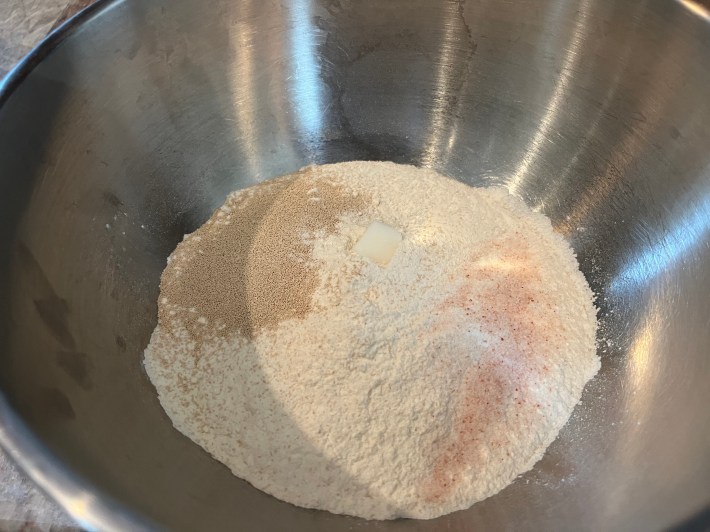
I also rubbed the lard in by hand, but instead of using warm water I used ice cold water. Because usually when you’re laminating it’s pastry, and with pastry you want the fat to stay cold, right? It did not occur to me until this very minute that actually we were not making pastry, we were making bread. And the cold water might actually have inhibited the yeast!
KM: Oh yeah! I did do that! I’m not actually sure why I didn’t do that this time. I guess I forgot! Wow! We really did do this differently. That does make sense. I used warm water because I assumed we would be kneading. I did in fact knead for so long. I set the timer for 10 minutes and kneaded the whole time and then my shoulders hurt. They still kind of hurt today to be honest. I’m out of baking shape.
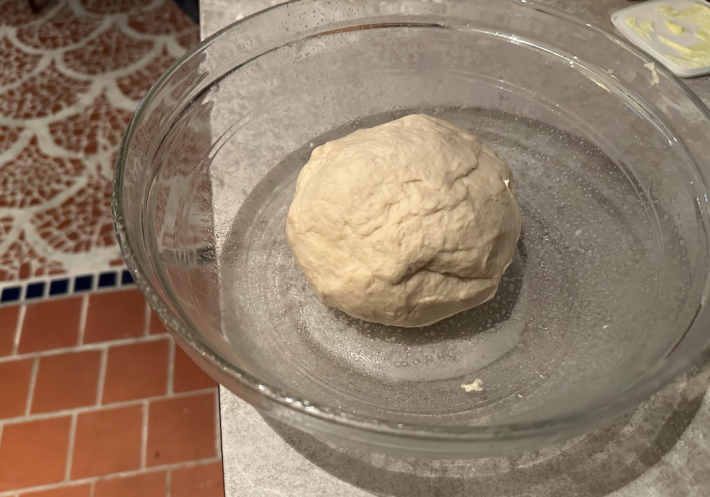
CT: I also did some kneading. I wasn’t going to—my dough was a lot like the pâte brisée dough for the tarte aux pommes, super crumbly and barely held together—but I reminded myself that one thing we were for sure not making was pie crust. It’s funny how all the baking principles get all scrambled in my brain by the end of a campaign. I just couldn’t wrap my mind around trying to laminate with a crumbly, short dough. So I kneaded it. And this felt right, and also just the physical sensation of kneading dough until it is nice and blobby and smooth is very satisfying. I think this temporarily calmed my mind a little.
KM: Yeah, now that I’m thinking critically about this and not just blindly moving, I’m not sure which is right. Because you absolutely got better lamination than me in the end, and it makes sense that you wouldn’t want to overwork a pastry dough. I just kind of went bread mode. I wish we got to knead more! Perhaps this is what I actually mean when I say I am “against the stand mixer,” is that there is something very relaxing and meditative to me about kneading. I like it.
CT: Yes! It’s crazy to go through 10 weeks of baking challenges and only spend, like, 25 total minutes kneading dough. Give me the dough blob!
KM: Let us dough blob!
CT: How did you manage this first proving session?
KM: Famously, the two of us have a lot of difficulty proving. Because this bake was three hours, I assumed it would be fine to use my oven. So I set the oven to 170 degrees. I planned to let it get up to 100 according to my little oven thermometer, and then open the door till it got to 80 and shove my dough into the oven. But I got distracted kneading. So the oven preheated all the way. So then what I did was I opened the oven door and sat the dough in its bowl on the door until the oven cooled down to 80 (like 10 minutes) and then I put it in there. I let my dough prove for 30 minutes.
How did you prove? Did you have to go bathroom-mode again?
CT: I did not! My plan (because this was just a sphere of dough inside a medium mixing bowl) was to use my microwave as a little warm space for proving. I had success with this when we made panettone last winter, filling in the space with little tea light candles and a mug of steaming water and just opening the door here and there to moderate the temperature. So my first move was to put my dough into the microwave with a mug of hot water. I figured I was in good shape.
KM: Yes! You were very successful with that!
CT: But! I then looked at the next instruction, which told us to use a microwave to infuse tea into our dried fruit, for the filling. As I only have one microwave, and as this instruction noted that this microwave step was “for speed”—an absolute necessity in this and all technical bakes—I felt that I could not opt for another method for steeping the fruit. But this meant that I had to very quickly improvise a new proving space in order to free up my microwave.

KM: Who has two microwaves? Something about the idea of this just had me envisioning the two of us doing this bake side-by-side in a company kitchen and everyone yelling at us.
I still don’t really understand this microwave portion. Basically we just put the dried fruit in hot water with tea bags and microwaved it? I feel that we could have simply poured boiling water on it. How much faster could this possibly have been?
CT: Yeah I don’t know anything about this process, it was totally mystifying to me, but I didn’t feel I had time to really consider it. I could’ve used my oven but I’d already set it to preheat to around 350 degrees for the bake, which was stupid because the actual baking was more than two hours away.
What I wound up doing is running down to the basement, dumping out the contents of a plastic storage bin onto the floor, then racing back upstairs and placing the upside-down storage bin over my dough, on the floor. I used an instant-read thermometer to check the temperature under there; after a few minutes, when it was still 68 degrees, I started putting warm things in there with it. First I tried a large metal flashlight, which for obvious reasons didn't do anything.
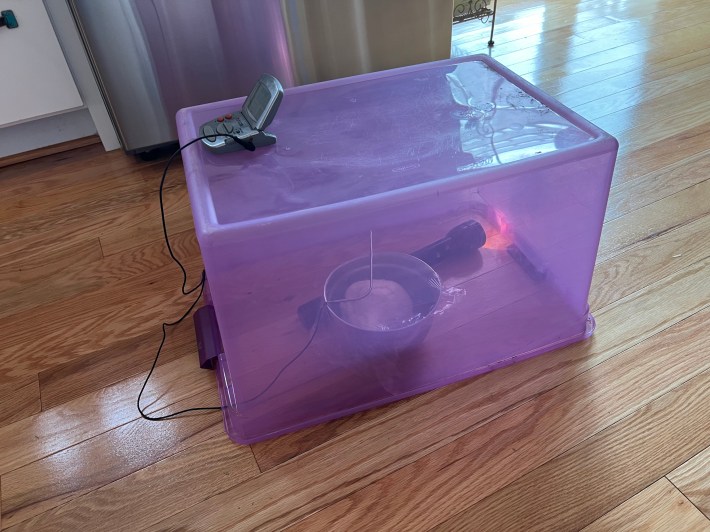
Then I added a bowl of steaming water, then two bowls of steaming water, then a single large bowl of steaming water plus the actual hot metal teapot, which I rested on a rubber thing in order to avoid burning my floor. Meanwhile steam condensation was causing my floor to become wet.
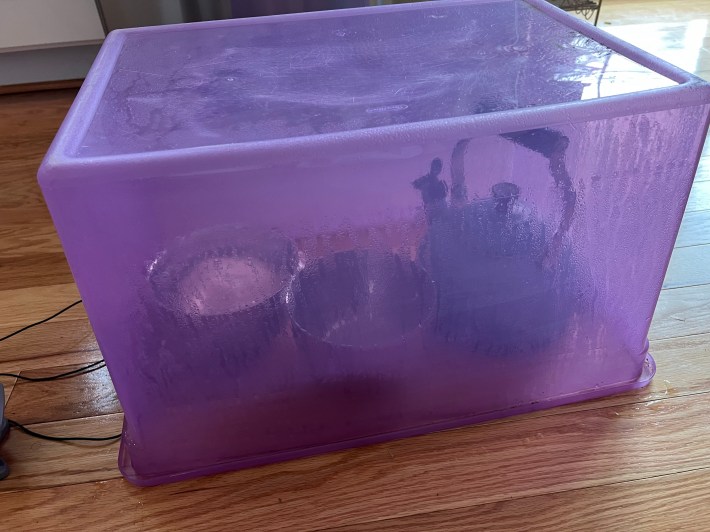
Eventually the temperature crept into the mid 70s, but of course I was pretty sure that I’d lost too much time and would never get a good rise in my dough. I felt very sweaty and flustered and bad.
KM: Okay, that’s very brilliant though. You made a heat dome! Just like the planet!
Ugh. I’m sorry. The proving is one of the few things (like the dishes) that I think would be drastically better for us in the tent. Having an actual proving drawer is such a leg up, but it also takes out all of the mental (and for you physical) gymnastics of trying to create a space to prove.
CT: Yeah, I agree. As stupid and confounding as this improvisation was, I liked that it did not involve a single-purpose piece of kitchen machinery. Whenever I use something like that—even a stand mixer—I picture an Italian grandmother from like the 18th century, baking fabulous bread using just a confined space and literal fire, and I feel ashamed and disconnected in some weird but essential way from, like, the arc of human ingenuity.
KM: We are the same on this. I rented this fancy house for my big Thanksgiving and it had every single-use appliance known to man. And I was sucking my teeth over it the whole week. These modern tech people and their stand-alone bread-maker! Grow up! Return to your roots! I am sure that bread-makers are great, but I am ornery and I think simply we should have less work and then people would have time to make bread. I don’t like the tech solutions. In fact, I hate them. Do NOT give me a small pizza oven. I wish to burn the shit out of my hand trying to make pizza in my own regular oven!
CT: Yeah! I think I would honestly feel ashamed if I served someone pizza from like a countertop pizza oven.
Stage Two: Making Candied Orange Peel, Infusing Fruit
KM: I have another bone to pick with this challenge if you will allow it.
CT: I certainly will.
KM: I am so fucking sick of making syrup. Syrup is delicious and I do like all the bakes we have had with it, but these citrus syrups (which was the next step for us) take a while to make, and are so sticky. And then everything in my damn kitchen is sticky and it takes an extra 45 minutes to clean the place when I’m done because I keep realizing that, like, the fridge door handle is sticky!
CT: I will say, yes, I think this season was heavy on the syrups. It was almost a theme, looking back. You and I have just constantly been flinging hot sugary syrup all over our kitchens.
I lost what felt like a lot of time making the syrup for this bake, just peeling oranges and then chopping the peel into cubes.
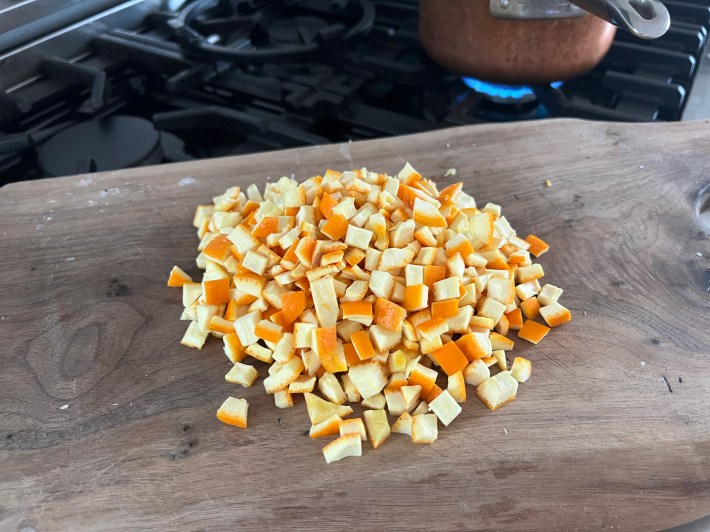
I wasn’t closely watching the clock but after the fiasco with the proving box I felt like I needed to be moving at hyper speed and I very much was not. It was like one of those dreams where you’re trying to run but your limbs are dragging through space as if through thick mud. I was genuinely distressed by how long this took. And I am in general a very respectable chopper!
KM: This is also something we did differently! I only peeled the oranges. I decided it would be too annoying for me to have a lot of little cubes floating around in there. So for both boils I left the peels intact and only chopped them into cubes when they were soft.
CT: Oh wow. I never even considered doing that. I’m not sure it would’ve been faster for me because it would’ve meant waiting for them to cool and also it would’ve meant handling something slimy and sticky, which causes me to freak out.
KM: You also love to make actual cubes. Whereas I just diced all the chunks of orange into whatever shape they became. I wish I had a perfectionist gene somewhere in my body. I am always sabotaging myself with my carelessness.
CT: Well, if it makes you feel any better, I am usually the bad kind of perfectionist, the one where it is one thousand times harder than it should be to start anything because all I can see are all the little points where I am likely to fail.
Just to circle back real quick: For the filling we also had to infuse tea into dried fruit using a microwave. I did this by covering the fruit with water in a glass bowl, then putting a tea bag in there, and then covering the bowl with a glass plate, and then putting it into the microwave for three minutes. After three minutes, when it really did not seem to be very infused, I did another three minutes. I wasn’t sure what the hell we were supposed to do with baking soda? So after it had cooled a little I just … dumped the baking soda in there? And it got all fizzy and bubbly for a couple minutes, which was fun.
KM: Oh yeah. I also did this! I put it in a glass bowl with a layer of plastic wrap that I jabbed holes into on top. I ended up microwaving for seven minutes because I set the timer for 10 and forgot about it. When I dumped the baking soda in, I panicked! Why did it do that! Why did it fizz? I did not pass the AP Chemistry test so I cannot be expected to know!

CT: Well! Science tells us that baking soda and water combine to make something called carbonic acid, which is the fizzy thing in soda. Or not, I really do not know. I also have no idea what any of this has to do with tea and fruit.
What kind of tea did you use for your infusion? I used a spicy holiday tea, which felt appropriate.
KM: Carbonic acid? Is this like when you pour Coca-Cola on your car battery to get rid of corrosion? I don’t care if this is correct. I choose to believe it. I used ENGLISH BREAKFAST TEA, mate. It’s on theme, innit?
CT: Blimey!
So you had your big orange peels, and you boiled them and then re-boiled them, and then cut them?
KM: Indeed! And then I put them in the syrup.
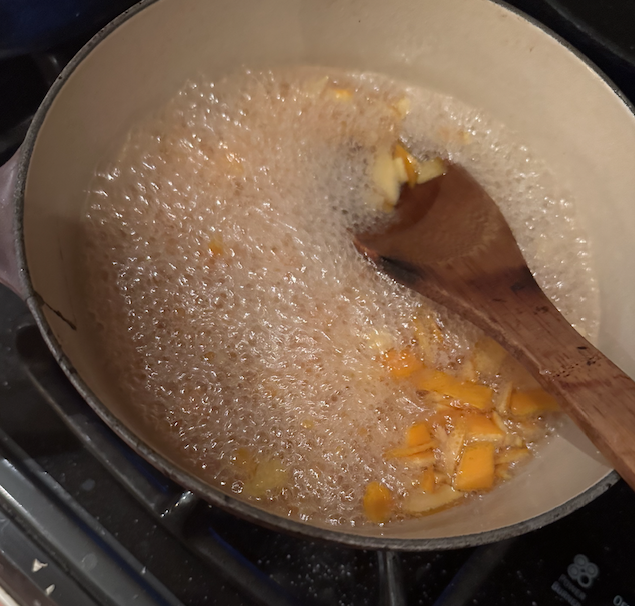
Then I sprinkled them with more sugar when they came out as a treat. Did you do this with your tiny orange cubes?
CT: Hmm, no, no sprinkling for me, although that seems like a very nice touch.
The instructions asked us to boil twice with “fresh water,” which is not the same thing as freshwater, as might be found in a river. But instead of using water and sugar to make syrup, I squeezed the flesh of the oranges and made the syrup from orange juice and sugar. It irritates me a lot when a recipe asks me to leech all the flavor out of something and then to eat it. Orange peels that have been boiled twice and then soaked in sugar water are going to be more blandly sweet than anything else. I wanted to put some orange flavor back into the orange peel, and so I did.
KM: You’re a genius. I love this plan, and I think you were right to do so. I also kind of did this in that after my candied oranges were done, I had my orange syrup, and I tasted this, and it did not taste very orange-y! I had already eaten one orange as a snack while I was cooking, so I just cubed up the other peeled orange and put it in the syrup on the stove and mashed it around a little bit for like 10 minutes and then drained the orange flesh. This made the syrup much more orange flavored.
CT: Nice. I almost feel like doing a U-S-A chant right now.
I had my infused fruit drying on a couple of paper towels, and I had my syrup-soaked orange peels in a colander, cooling, and I had my syrup reserved in a bowl, and I had my mixture of brown sugars. I didn’t want to wait long for anything, so I just added the fruit to the still-warm candied peel, dumped in the sugar, stirred it all around, and then ran downstairs and socked it into my freezer, so that it would not still be hot when I had to put it into the raw dough.
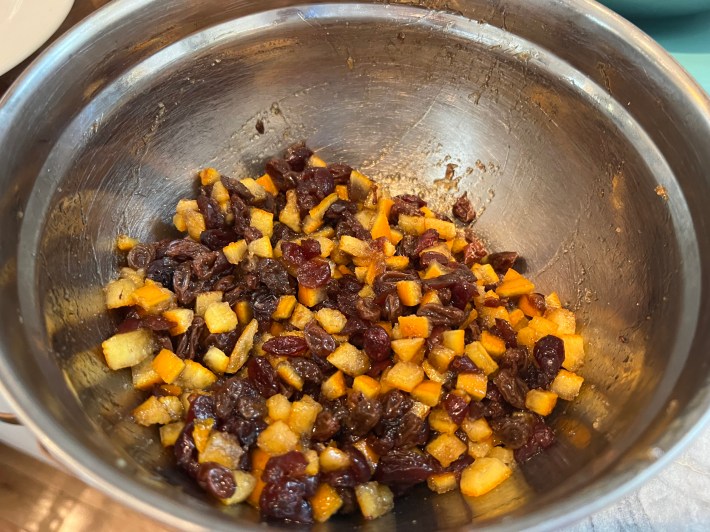
KM: One of my favorite things about us is that despite being absolute idiots who blog for a living, we are always doing things we are certain are better and smarter than Paul Hollywood and Prue Leith, both of whom have been professional bakers for decades. And sometimes, SOMETIMES, we are right!
CT: Yeah I mean it’s entirely possible that I was wrong, but I am also sort of compulsively an aesthetic maximalist when it comes to cooking, I simply cannot abide using as an ingredient an orange peel that no longer tastes or smells of orange.
KM: I put all my stuff in the fridge for like five minutes so it could become less hot. This did not really work by the time I was ready to use it, but I tried. I should have put it in the freezer.
Stage Three: Laminating, Filling, Proving
CT: So I assume now you were ready to unwrap your dough and begin rolling it out? Do you have a sense of how much time you still had left in the bake?
KM: I do because I was right on schedule, which means that I pulled my dough back out with a full two hours left in the bake. This felt good. And my dough had risen so much that I was proud of it, but slightly concerned I had somehow over proofed it. It was very puffy.
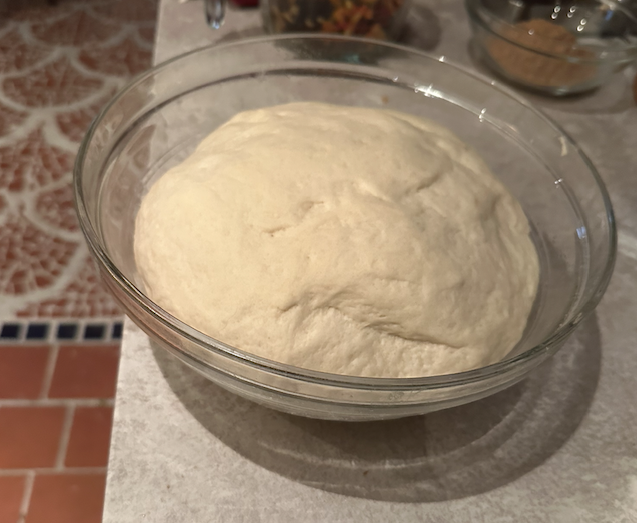
How much time did you have left?
CT: I’m not really sure, but definitely less than two hours. Something I have failed to mention so far is that during the part of the bake when I was making candied orange peel, my part of the world lost electricity for something like 20 minutes.

So for a stretch of time here I was cooking in a dark kitchen, using a lighter to light the burners on my stove, and trying to keep rising panic from overwhelming my senses. I think I did a pretty good job of remaining calm, especially after I was able to confirm with my power company that the shut-off was not due to my having forgotten to pay a bill. The Thompson household is, in fact, current on all monthly bills. Whew.
KM: Oh, yeah! That was so chaotic! We used to lose power at my house a good amount when I was growing up during tornado season, and I still feel a very misplaced romanticism for the lights being out. So secretly, I was a little jealous even though my kitchen is literally underground and would have been pitch black.
CT: I don't think I lost much time to the power outage, other than the quick call to report it. I wasn't actively using much machinery, although my oven—which had been holding at 350 for a while—did shut off.
By the time I finally pulled my dough out of the proving box it had risen a lot, but I couldn’t help but fear that it had spent more time in there than intended, and therefore might have risen too much. Like at a certain point your yeast eats its fill and stops eating and your dough sinks and then Paul gets to say the word “concertina” as he looks up disapprovingly from your deflated bake. Still, I would say it was encouraging to see that it had risen at all. You never know!
KM: Yes! Exactly! I always worry that my yeast will be dead because sometimes it is! But my dough was very elastic and I was proud of it for a moment. When I rolled it out, I felt cocky, but that feeling lasted for exactly one envelope fold.
CT: Oh no! What happened?
KM: Well, Chris. What happened is still unclear to me. What I think happened is that I filled my dough with a third of the filling. Folded it, and then I made a crucial error (I think). I am not certain that I did this, but I think I flipped the dough before I rolled it again, which meant that the filling was very close to the top. I managed to roll it out okay, but then when I added more filling to that same side, on the second fold, the dough began to split, and the fillings began to seep out! I was so sad!
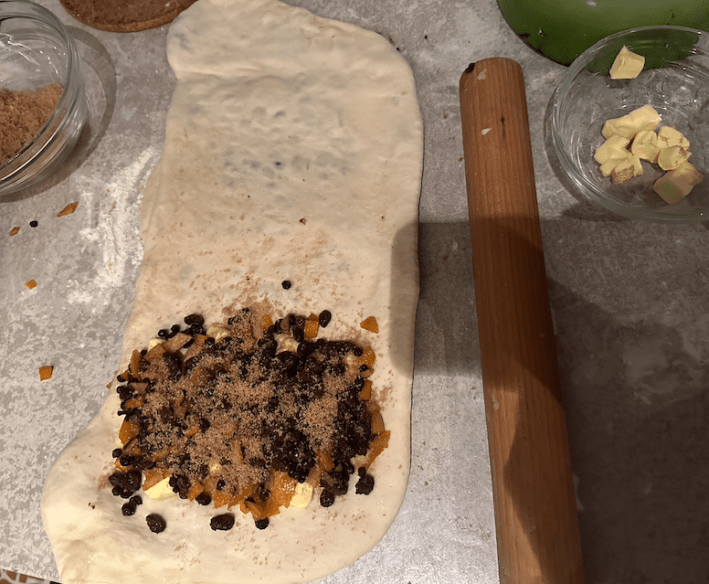
CT: Oh no!
KM: What is most brutal about a filled bake like this, is you cannot reverse the mistake at this point. The fillings were mixed in. I still had a third of them left. I just had to continue forward. This felt very bad. But I did it anyway. The only thing encouraging me was that it smelled really good. So I felt hope in my heart.

CT: That’s so discouraging. So it sounds like your filling was sort of squished together and then there was a thick layer of dough that did not have filling?
KM: Yes that is exactly what happened. I did manage to put the third layer of filling in the right place, but by then it was too late.
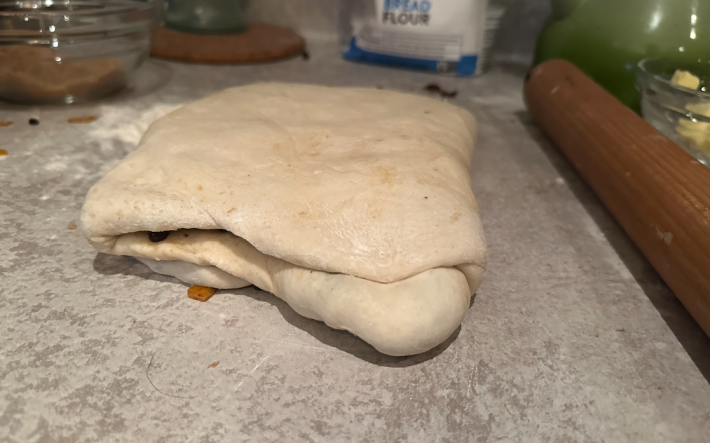
CT: Tragic!
I felt really good about my dough, possibly just because it was so pliable that I had a very easy time manipulating it, and so I felt very skilled and capable. I had a space of time when I was waiting for my filling to cool enough for use and so I had pre-chopped my lard into little dots, and I had socked a stick of butter in the freezer for this moment. So I used a third of my cooled lard dots and then grated a third of the butter, and then spread a third of the filling, and did the first fold.

KM: I love that for you! Wow. I think grating was so smart. I wish I had thought of that. My last attempt to grate butter, theoretically, should dissuade me, but I have no sense of self-preservation.
CT: It became slimy pretty quickly and at one point I added flour pretty generously to combat this problem. To be honest this laminating stage went very smoothly, overall, other than the slimy part. Hate slime!
KM: Not slimy! I truly love to hear that it went well for you, because I felt like it could have gone so well for me and that I had just flubbed it.
CT: One thing that worried me after the third fold, when I rolled out the final shape, is that I didn’t get it all the way to the edge of my roasting pan, and I wasn’t sure what that would mean for the final bake.
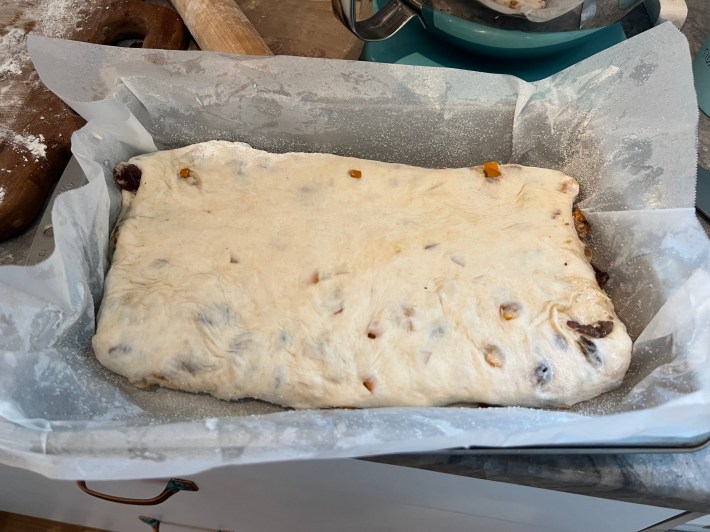
But I didn’t want to handle it very much—the slime—and I didn’t want to spend any more time than absolutely necessary. So I just popped it back into the proving box. Space was an issue now, because there was a whole big roasting pan to fit under there. I was able to squeeze in two bowls of steaming water. Temperature control remained a challenge throughout.
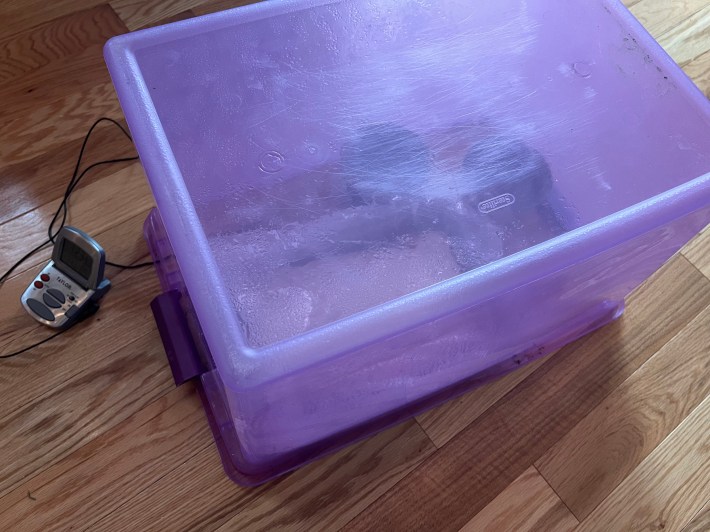
KM: I had a big debate with myself here about whether or not it was a good idea to proof for the second time in the oven knowing that my oven would then have to preheat, wasting precious time. I decided that since the proof went so well the first time in the oven, I would risk it. So it went back in the oven. At this point, I had free time, so I ate a bowl of leftover chili standing at the bar. I felt like a chef.
CT: Chef mode! How was the chili?
KM: It was so good. I have been making a lot of recipes out of Melissa Clark’s cookbook Dinner, and this one was pork with white cheddar and sage, which is not usually my chili modus operandi, but it slapped!
CT: It is chili season!
I used this second proving phase to wrangle my kitchen back into reasonable shape. Things had gotten pretty bad, with flour and syrup all over the place. I was super worried about time. I’m checking the Slack logs and it looks like I had something like 80 minutes left when I started the second proof? And I was thinking with all the stuff that was now weighing down the dough that it would need at least 30 minutes in there, especially given my struggle to maintain a good warm temperature. And then it would need at least 35 or 40 minutes of baking time, and then it was supposed to cool completely before the end of the bake. That all just seemed totally impossible to me.
KM: You were very worried about time. I, luckily, had plenty of time. I let my bake proof a second time for another 30 minutes. I was still on my planned pace. I was about to begin my dishes in this phase, when Trey came down and did them for me. I could have cried I was so grateful. The dishes are the real villain in this whole series.
CT: It can be so destructive to the psyche to reach a brief reprieve from actively baking and turn around and see a huge mountain of dishes, some of which you will need to re-use before the end of the bake, others of which are covered in syrup and flour and will be hellish to clean.
How did you feel about this proving stage? Like, as you watched your dough? Because I did not like what I was seeing inside that damn purple box.
KM: I felt bad, my dude! Because my dough was so beautiful and puffy after the first rise, I expected it to do this again. It did not! It barely got puffier at all. And I did not roll out my dough exactly because I expected it to rise, so then I ended up feeling sad and my dough was not touching the corners, so I had to smush it out a little. None of this felt good.
CT: Yep, this was my experience as well. To my eyes my dough wasn’t really rising, it was just sort of relaxing and becoming soft. And I was sure that I would not be able to extend any more time for this, not without running out of time in the actual bake. I decided that I would put my lardy cake into the oven absolutely no later than the 45-minute mark, no matter what else happened.
But when that time came at last I did not feel that my dough had risen really at all. I was prepared for the rest of this to be a disaster.

KM: I had plenty of time, luckily. I took my dough out of the over with an hour and twenty minutes left, let the oven preheat to FOUR HUNDO and then threw the cake in with a 35 minute timer.
CT: Wow, 400 degrees! That was bold of you, although the record will reflect that your oven tends to run cool, whereas mine is like the fires of hell. Our instructions helpfully gave us a temperature—unhelpfully the temperature was in celsius—so I stuck as closely as I could to that. My oven was set to approximately 350 degrees.
KM: It sure does! Famously, I also don’t believe the degrees matter as much as everyone else because (again) I did not pass the AP Chemistry exam (I got a 2).
Stage Four: Baking, Soaking, Cooling
CT: So you had most of an hour left when your lardy cake went into the oven?
KM: An hour and fifteen!
CT: Holy cow! Kelsey, that’s amazing. If your lamination had gone better you would’ve been incredibly ahead of the game at this point.
KM: I know. It’s tragic.
CT: Were you watching it pretty closely in the oven? I was planted in front of the little window with my face glued to the glass and the timer sitting on the floor next to me. I was powerless at this point.
KM: I was! Because the dishes were done, I was able to pay attention. I sat on the ground, and I did not love what I saw because it began to rise in the center of the bread. This, I did not like because I knew that it was supposed to be flat on top and become nine equal pieces. I did not like the doming. But I could do nothing about it.
CT: My lardy cake also domed in the middle as it baked, which I also found worrying. On the other hand, I reasoned that if it was doming in the middle then it had to also be cooking in the middle, and since I was most concerned that I would not be able to get it to fully cook, this was somewhat encouraging.
My oven heats very unevenly so after maybe 10 minutes I popped the door open and rotated the lardy cake. Parts of it had already started to get a little color but in weird patterns that did not seem to square with anything that I expect to be true about the heat distribution inside of an oven. I knew that I had at my disposal a very dangerous weapon, for emergency use only: My oven has a deeply dreaded High Bake mode that engages the upper coils. In my experience this is the setting you engage when what you are hoping to do is to burn your house down. It’s just out of control. A repair person explained to me once that the temperature sensor thing attached to this upper coil is busted and so there’s basically no regulation of the heat it throws off. It’s like the red DO NOT PUSH button on the dashboard of a car driven by Wile E. Coyote and made by ACME.
KM: Not High Bake! Not High Bake! I’m so scared!
We were having such different experiences. I removed my bake from the oven with 45 minutes left. Let it cool for 10, realized it was still raw in the middle, popped it back in for ten, and it came out fully baked with 25 minutes left still.
CT: When you told me you were putting your lardy cake back into the oven a chill ran down my spine. I had a flash memory of a time last season when you threw away a completed pie crust with like half an hour left in a bake and started it over from scratch. But I guess if it was raw your hand was forced. Also you had plenty of time left.
I had planned to pull my lardy cake out of the oven with 10 minutes left, to immediately brush it down with syrup, and then to race it into the freezer. But this meant that it HAD TO be finished baking, which meant that it would get a maximum of 35 minutes in the oven. When it was still not browned to my satisfaction with 11 or so minutes left in the bake, I engaged High Bake and left it for God to decide.
KM: I had brushed the top of my lardy cake with syrup when it came out very early, so when it went back in, it became very beautiful on the top. This was to my advantage.
CT: Oh! That’s interesting. Did it crisp up? Or like brown better? Now I wish I had done this.
KM: Yes! For the ten minutes it was in there becoming fully baked, it also became crispy and kind of shiny.
So then when it came out, I flipped it over, and stabbed a bunch of holes in it with a toothpick, and brushed the syrup on. There was so much syrup. I had like maybe a cup and a half of syrup. But I liked the syrup, and I had babysat it, so I made it all go in to the cake.
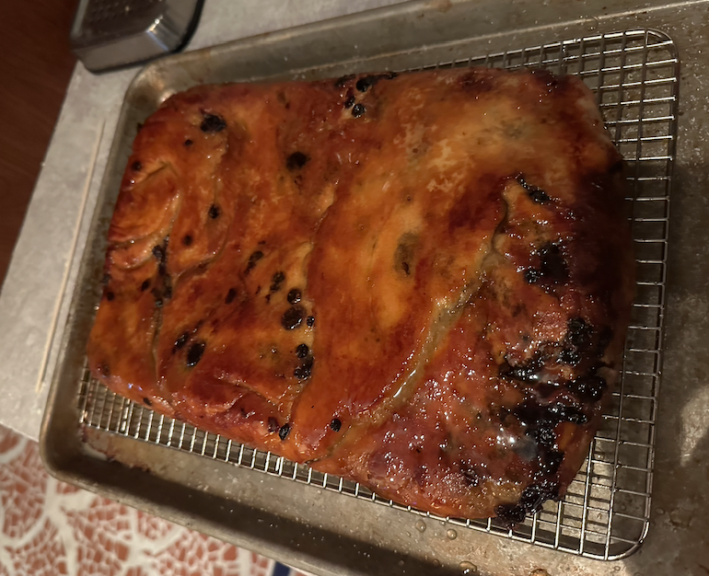
Did you use all your syrup?
CT: Oh, that’s so nice.
I didn’t use all of mine. I got very lucky, in the end. The High Bake setting did not char my lardy cake, and in fact I think if I had not engaged it my lardy cake would not have been baked in time. It was very bad looking when I took it out but that was more from uneven heat and what might've been popping sugar and fat on the few exposed pieces of fruit, but it was unquestionably fully baked.
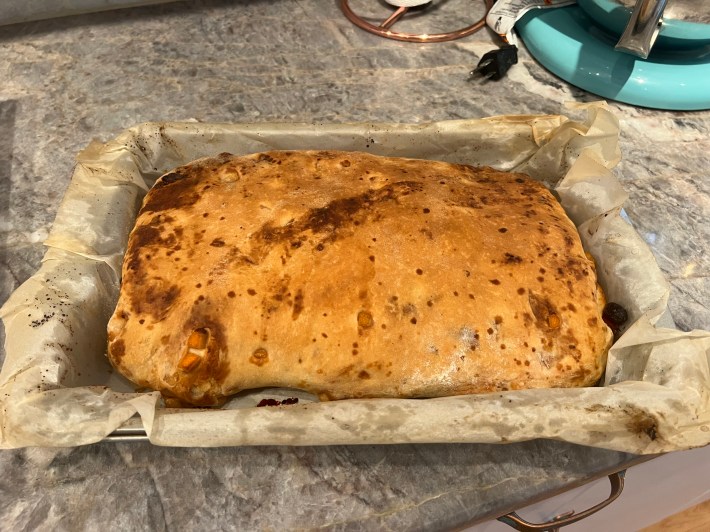
I was so short on time that I couldn’t really afford to brush the syrup on very carefully, so I was just kind of slopping it on there heavily and wiping it around more quickly than it could absorb. For another thing, I didn’t think to puncture the lardy cake with a toothpick or skewer. Mainly, the bottom of my lardy cake was cooked very dark, almost to the point of charring, and so it was sealed up pretty good.
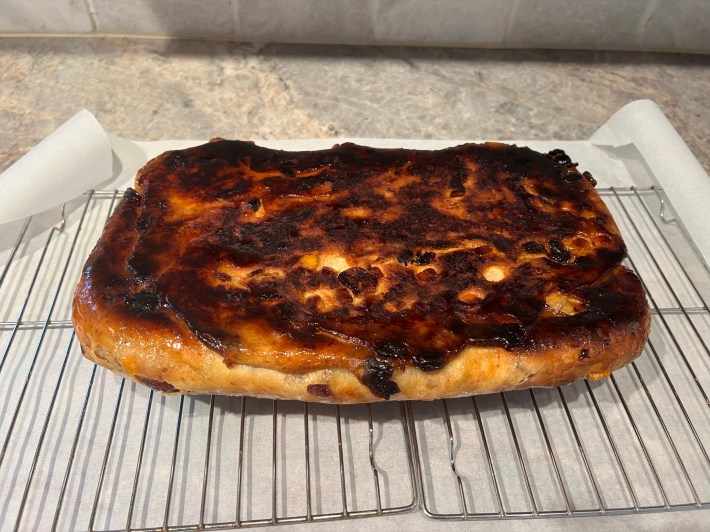
If I hadn’t had a timer I would’ve just left it to cool and occasionally brushed on another layer of syrup until all the syrup was used, but this wasn’t an option. I slopped a bunch on there, slopped a bunch on the top, wiped it around, and then raced it downstairs to the freezer for I think six or seven minutes of blasted cold. The instructions were specific about letting this damn lardy cake cool completely before cutting.
KM: I also put my lardy cake in the freezer for ten minutes, and it was still warm when it was withdrawn from the freezer. Whatever! I had to cut it!
CT: Yeah! After three hours of baking, I think we both didn’t get to the cutting of our lardy cakes until the final minute. A close call!
The Finished Product
KM: It always is, isn’t it!
CT: Kelsey, are you prepared to show your lardy cake?
KM: I am, though I am not very satisfied with my lardy cake. I am ashamed of its poor lamination. Here is my cake:
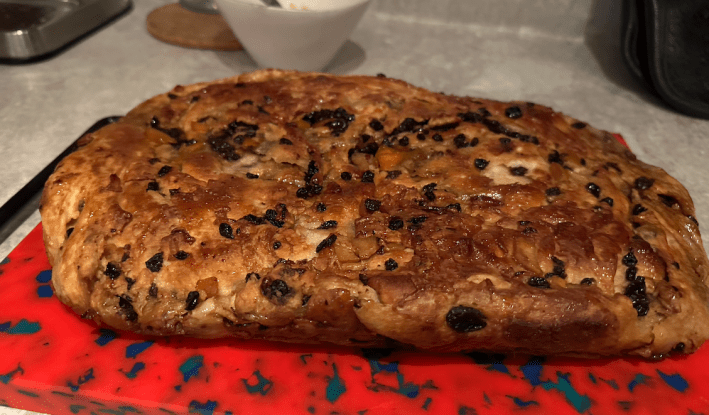
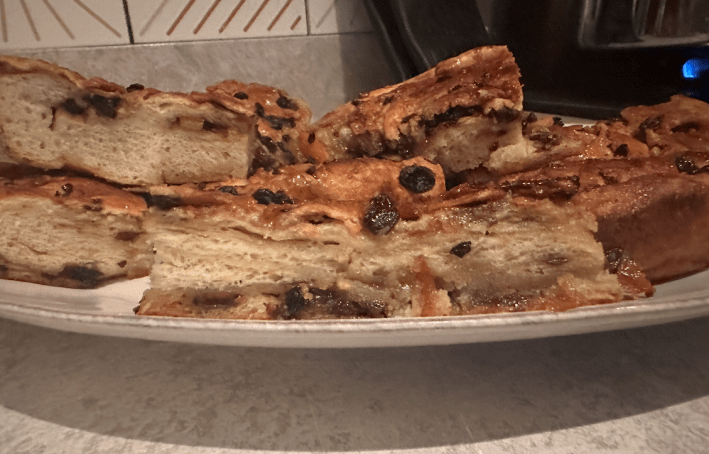
CT: It’s a very nice lardy cake, it looks spectacular from the top. Did you still have some hope that you would cut into it and see beautiful layers, or were you pretty well prepared for what you saw?
KM: I did hope that I would cut into it and see layers. I am nothing if not naive. Show your lardy cake? How do you feel about it?
CT: Here is my lardy cake:
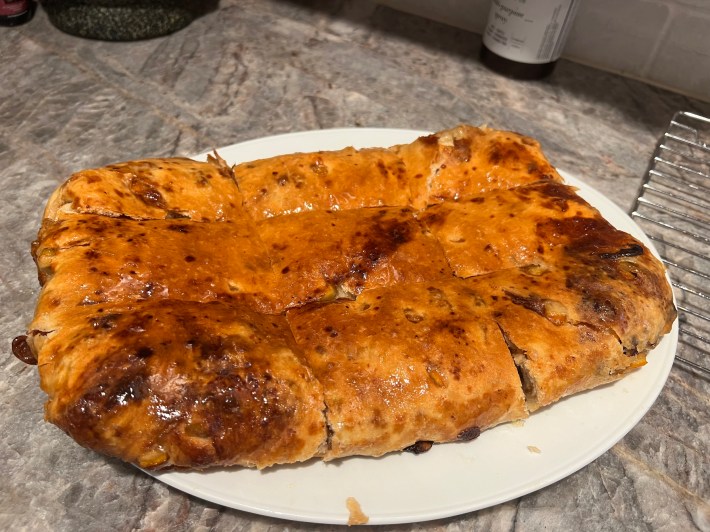
From the outside it looks like a focaccia that has been wrapped in the mottled skin of Mr. Burns. But I’m pretty proud of the inside of it. The filling is distributed pretty evenly and the layers are really distinct, there’s no missing them.
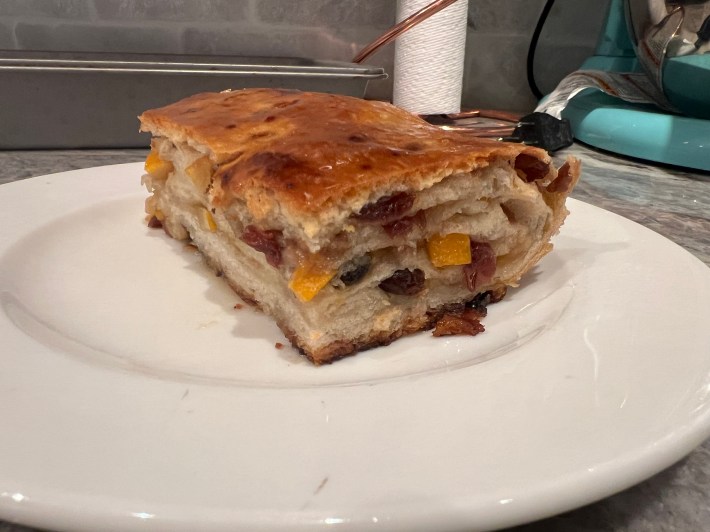
KM: Look at those layers, damn!
CT: Did you get a chance to eat your lardy cake? What did you think of it?
KM: I thought it was very sweet, but overall extremely good. It tastes like the holidays, which is nice!
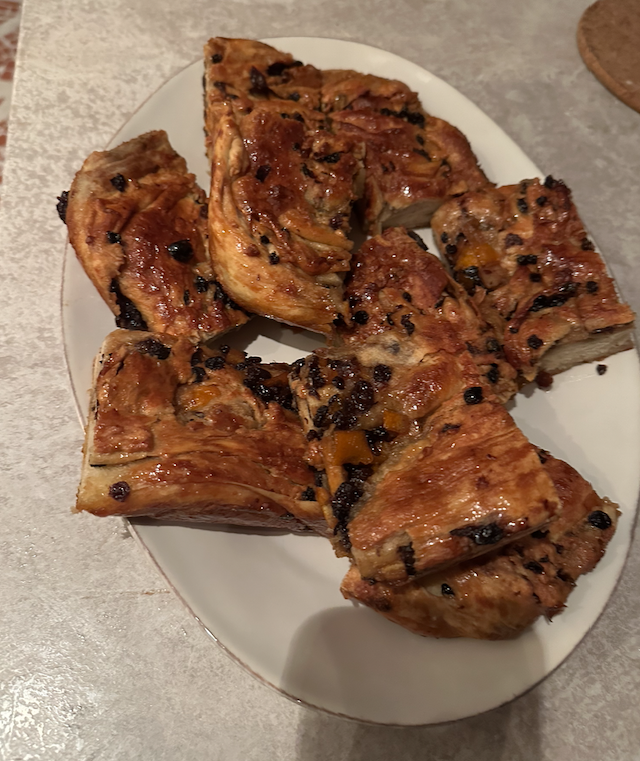
CT: Yeah I’ve got to hand it to Paul Hollywood. This is a tasty treat. The tea infusion was fussy nonsense but other than that I can’t complain.
KM: I do have to admit that I do not taste the tea at all in this final product.
CT: Same. Maybe we did the wrong thing with the baking soda? No one would ever guess that the fruit has been infused with tea. If Paul Hollywood told the show’s contestants that he could taste the tea he was 100 percent lying to them.
Kelsey … that was it! We have completed the final technical challenge of the season!
KM: We did it! We won the bake off! Unlike last year, we did it! For the first time ever, two people have been crowned co-winners!
CT: Unfortunately we have been forced to split the trophy, which meant smashing the engraved cake stand to hell and then distributing its powderized shrapnel via Ziploc bags. Still, pretty sweet!
KM: I love my Ziploc bag and I will cherish it.
CT: Kelsey, it’s been a pleasure. I will see you again in the baking space when it is Panettone Time.
KM: Likewise. It is always a joy. It is time for me to begin feeding my sourdough starter in preparation! Until then!






